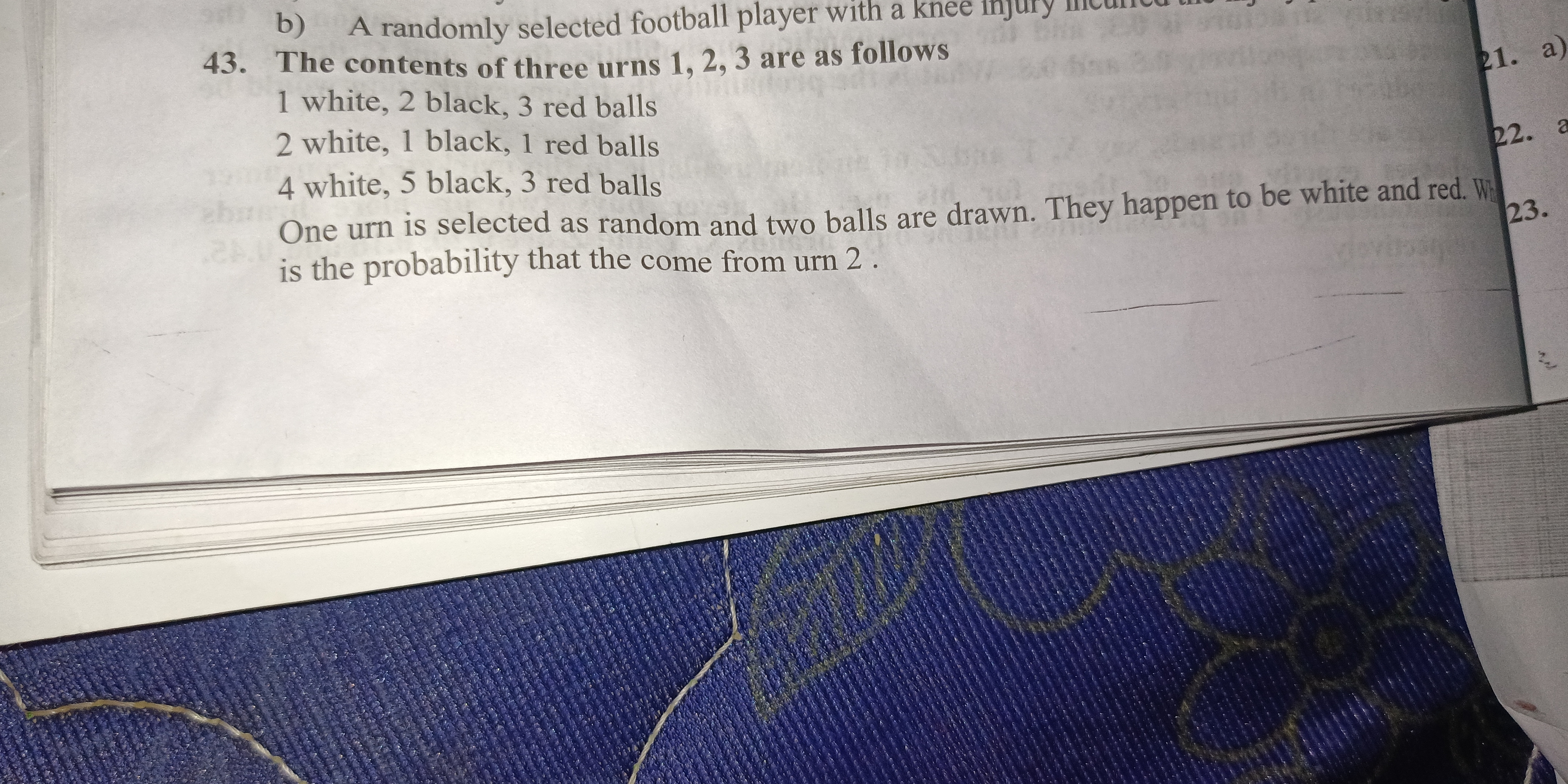The contents of three urns 1, 2, 3 are as follows: 1 has 2 black, 3 red balls; 2 has 1 black, 2 white, 1 red balls; 3 has 5 black, 4 white, 3 red balls. One urn is selected at rand... The contents of three urns 1, 2, 3 are as follows: 1 has 2 black, 3 red balls; 2 has 1 black, 2 white, 1 red balls; 3 has 5 black, 4 white, 3 red balls. One urn is selected at random and two balls are drawn. What is the probability that they come from urn 2?

Understand the Problem
The question is asking for the probability that two balls drawn (one white and one red) came from urn 2, given the contents of three urns with different colored balls. This involves determining conditional probability using the information provided.
Answer
The probability that the two balls drawn came from urn 2 is \( \frac{11}{17} \).
Answer for screen readers
The probability that the two balls drawn (one white and one red) came from urn 2 is ( \frac{11}{17} ).
Steps to Solve
-
Identify the Urns and Their Contents
Urn 1: 2 black, 3 red
Urn 2: 1 black, 2 white, 1 red
Urn 3: 5 black, 4 white, 3 red -
Determine the Total Probability of Selecting Urn 2 and Drawing One White and One Red Ball
Using the law of total probability:
We need to find the probability of drawing one white ball and one red ball once Urn 2 is chosen.For Urn 2, the total number of balls is:
$$ 1 + 2 + 1 = 4 $$
To choose one white and one red:
$$ P(\text{White, Red | Urn 2}) = \frac{{\text{Number of ways to pick 1 white}} \cdot {\text{Number of ways to pick 1 red}}}{\text{Total ways to pick 2 balls}} $$ The number of ways to choose 2 balls out of 4:
$$ \binom{4}{2} = 6 $$
The number of ways to choose 1 white and 1 red:
$$ 2 \cdot 1 = 2 $$
Hence,
$$ P(\text{White, Red | Urn 2}) = \frac{2}{6} = \frac{1}{3} $$ -
Calculate the Total Probability of Drawing One White and One Red Ball from All Urns
We need to find the probabilities for each urn:
- Urn 1: No white balls, so $P = 0$
- Urn 2: As calculated, $P(\text{White, Red | Urn 2}) = \frac{1}{3}$
- Urn 3: Total number of balls = 12.
Choosing one white and one red:
Ways to choose 1 red: 3
Ways to choose 1 white: 4
Total ways to choose 2 balls:
$$ \binom{12}{2} = 66 $$
Hence,
$$ P(\text{White, Red | Urn 3}) = \frac{3 \cdot 4}{66} = \frac{12}{66} = \frac{2}{11} $$
Total probability of drawing one white and one red ball from all urns is:
$$ P(\text{White, Red}) = \frac{1}{3} \cdot \frac{1}{3} + 0 + \frac{2}{11} \cdot \frac{1}{3} $$
Calculate:
$$ P(\text{White, Red}) = \frac{1}{9} + \frac{2}{33} $$
Find a common denominator (99):
$$ = \frac{11}{99} + \frac{6}{99} = \frac{17}{99} $$ -
Use Bayes' Theorem to Find the Conditional Probability
We want ( P(\text{Urn 2 | White, Red}) ):
$$ P(\text{Urn 2 | White, Red}) = \frac{P(\text{White, Red | Urn 2}) \cdot P(\text{Urn 2})}{P(\text{White, Red})} $$
Since each urn is equally likely to be chosen, ( P(\text{Urn 2}) = \frac{1}{3} ):
$$ P(\text{Urn 2 | White, Red}) = \frac{\left(\frac{1}{3}\right) \left(\frac{1}{3}\right)}{\frac{17}{99}} $$
Simplifying:
$$ = \frac{1}{9} \cdot \frac{99}{17} = \frac{11}{17} $$
The probability that the two balls drawn (one white and one red) came from urn 2 is ( \frac{11}{17} ).
More Information
This problem illustrates the application of conditional probability and Bayes' Theorem. Understanding how to structure the problem into parts with known quantities is key to solving it accurately.
Tips
- Neglecting to calculate the total number of ways to choose balls from the urns correctly.
- Forgetting to include all possible urns when finding the total probability of drawing the specific balls.
AI-generated content may contain errors. Please verify critical information